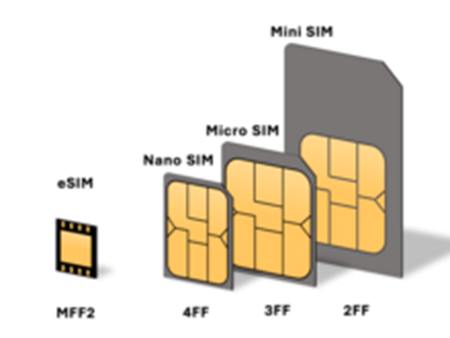e-SIM Technology: Redefining Connectivity from Mini to Micro to Nano
"e-SIM Technology: Redefining Connectivity from Mini to Micro to Nano"
Odyssey of “The SIM”
In the dynamic world of
telecommunications, the advent of e-SIM technology stands as a revolutionary
transformation, reshaping the way we connect and communicate. To truly grasp
the magnitude of this innovation, let us embark on a journey tracing its
evolution from mini-sized SIM cards to the present-day e-SIM marvel.
Commencing with the conventional
mini-SIM cards that have long been a fixture in mobile devices, the industry
witnessed a transition to micro-SIM cards, introducing a more compact form
factor while maintaining compatibility. Subsequently, nano SIM cards entered
the stage, further reducing the size. Each iteration sought to enhance user
convenience and facilitate sleek, sophisticated device designs.
Now enter e-SIM technology,
representing the pinnacle of SIM card evolution. Unlike its physical predecessors,
e-SIM, or Embedded Subscriber Identity Module, is a virtual entity seamlessly
integrated into the device's hardware. This groundbreaking technology
eliminates the physical card, introducing unparalleled flexibility for both
device manufacturers and users. At its essence, e-SIM technology operates by
securely storing subscriber information and authentication details in a chip
embedded within the device. This virtual SIM card can be programmed and
reprogrammed over the air enabling users to switch carriers without the
cumbersome process of physically swapping SIM cards. This seamless integration
streamlines the activation process, marking a new era of efficiency and
user-centric design.
The Pros
The advantages of e-SIM
technology are multifaceted. Primarily, it eradicates the inconvenience of
handling physical SIM cards, offering users an experience that is both
convenient and efficient. Devices equipped with e-SIM support can effortlessly
switch between carriers, fostering healthy competition in the
telecommunications industry. Furthermore, the technology unlocks new
possibilities for connected devices, such as smartwatches and IoT devices, by
eliminating the need for physical SIM card slots.
Future of E-SIM Technology
Gazing into the future, the
trajectory of e-SIM technology is undeniably promising. As more devices embrace
this virtual solution, we can anticipate a surge in interoperability and
seamless connectivity across an array of gadgets. This technology is poised to
play a pivotal role in the expansion of the Internet of Things (IoT) and the
evolution of smart cities, where a myriad of interconnected devices
communicates smoothly.
E-SIM: A Friend of the Earth?
Engaging aspects of e-SIM
technology extend beyond its technological marvels. Notably, its positive
impact on the environment stands out as a key advantage. By eliminating the
need for physical SIM cards, e-SIM plays a vital role in reducing electronic
waste, aligning with global sustainability efforts. The programmable nature of e-SIM
introduces a host of advantages in the telecommunications sector. It not only
facilitates seamless switching between carriers, enhancing user convenience,
but also opens avenues for innovative business models. The dynamic,
reprogrammable features of e-SIM empower users to tailor their connectivity
plans according to their evolving needs, fostering a more personalized and
responsive approach from service providers. Additionally, the elimination of
physical SIM cards presents an opportunity for enhanced device design and
functionality. E-SIM technology allows for sleeker and more compact device
profiles, paving the way for innovative designs and greater flexibility in
product development.
To make a long story short
e-SIM technology signifies a transformative
chapter in the evolution of SIM cards, transitioning from mini to micro to
nano, and now to the virtual realm. Its efficiency, flexibility, and
eco-conscious benefits position e-SIM as a trailblazer, poised to redefine the
way we stay connected in an increasingly interconnected world. As the digital
landscape continues to evolve, e-SIM technology stands at the forefront, ready
to shape the future of connectivity and communication.
References
[1] J. H. a. M. Jansen, "digitaltrends," Digital Trends Media Group, 2006. [Online]. Available: https://www.digitaltrends.com/mobile/esim-explainer/. [Accessed 25 January 2024]. |
|
[2] "Wikepedia,"
Wikimedia Foundation, 15 January 2001. [Online]. Available:
https://en.wikipedia.org/wiki/ESIM. [Accessed 25 January 2024]. |
|
[3] "airtel,"
Bharti Airtel Lanka (Pvt) ltd, 12 January 2009. [Online]. Available:
https://www.airtel.in/blog/prepaid/esim-advantages-disadvantages/.
[Accessed 25 January 2024]. |
|
[4] "IoTDesignPro,"
[Online]. Available:
https://iotdesignpro.com/news/how-e-sim-technology-transforming-peoples-lives-and-the-industry.
[Accessed 25 January 2024]. |
|
[5] Y. Kuznietsov,
"Global YO," Global YO, 2022. [Online]. Available:
https://www.globalyo.com/the-sustainable-future-of-esim-technology-reducing-waste-and-promoting-environmental-responsibility/.
[Accessed 25 January 2024]. |


